By Tyler Rossi for CoinWeek …..
Popularized in the 1560s by French Huguenots and Scottish Presbyterians, communion tokens quickly became a staple of northern Calvinism. These tokens first came into use as a result of an admonition by the French theologian and reformer during the Protestant Reformation. He stated that in order “to prevent the profanation of the Lord’s Table,” it was necessary to use tokens or some other form of identification that would act as proof that the individual had passed a spiritual “examination”.
Unlike Roman Catholicism, many Presbyterian churches in the 1500s administered the Lord’s Supper, a form of communion, once or twice a year. Before each ceremony, the pastor or community elders would interview every communicant and distribute tokens to those who were deemed “worthy”. During the services, the token–also called a méreaux in French–would be given to the minister.
 By the 1600s, this practice was adopted in the Belgian city of Liege. Interestingly, the Roman Catholic cathedral of Liege also produced communion tokens during this same time period. All of the tokens from the 17th and 18th centuries produced in Liege commemorate Saint Lambert of Maastricht. Bishop of Maastricht-Liege, Lambert lived from 636 to 705 CE when he was murdered by agents of the Frankish Merovingian dynasty. While few details of his life are known, historians and religious scholars have agreed that he was “stabbed with a javelin” during mass in Liege’s Chapel of Saints Cosmas & Damian for “criticizing … Pepin of Heristal for his adultery”.
By the 1600s, this practice was adopted in the Belgian city of Liege. Interestingly, the Roman Catholic cathedral of Liege also produced communion tokens during this same time period. All of the tokens from the 17th and 18th centuries produced in Liege commemorate Saint Lambert of Maastricht. Bishop of Maastricht-Liege, Lambert lived from 636 to 705 CE when he was murdered by agents of the Frankish Merovingian dynasty. While few details of his life are known, historians and religious scholars have agreed that he was “stabbed with a javelin” during mass in Liege’s Chapel of Saints Cosmas & Damian for “criticizing … Pepin of Heristal for his adultery”.
One of the most common types of these tokens was struck in copper for 30 or 40 years. Since most examples of this type are undated, it is difficult to accurately state when they were struck. The earliest dated examples were struck in 1653 and depict a skull and crossbones memento mori on the obverse. As discussed in my previous article, “On the German Death Thaler of 1679“, these symbols representing the inevitability of death were a central part of European religious life starting in the late 16th century. Struck under the auspices of Maximilian Henry of Bavaria, the Prince Bishop of Liege, these small copper tokens are physical reminders of the intense religious devotion of the city’s population.
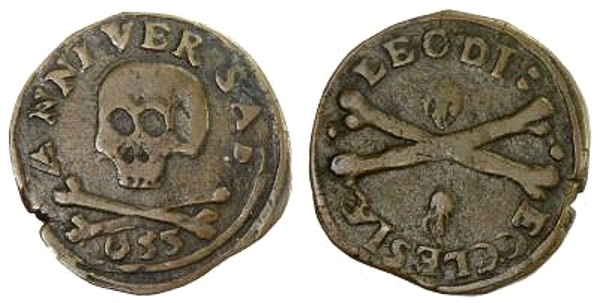
The design changed little over the decades, with all the same elements present. The only two differences are the direction that the skull is facing on the obverse and the obverse legend. Otherwise, it is clear that there was a series of different dies used because there are small variations across the different examples.
For instance, this example dated 1686 depicts the skull as almost fully forward-facing instead of a 3/4th portrait also the ANNIVERSAR is changed to ANNIVERSARIVM. Later tokens also include much more detail in both the skull’s features and the dual flames on the reverse. The legends are slightly better defined and more clearly engraved. While this can be partially attributed to ware, since the latter example is in much better condition, it is also clear that the dies were more skillfully prepared.

The non-dated examples have all the same devices as the later examples except, of course, for the date, which is usually found beneath the skull and crossbones.
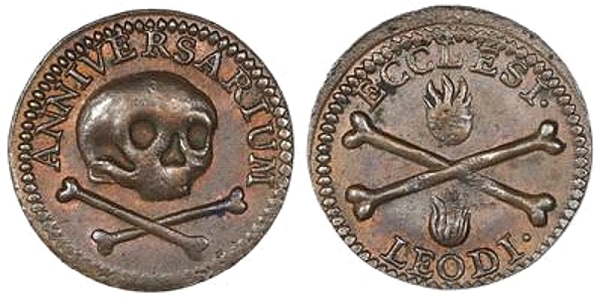
High-grade examples of this memento mori méreaux commemorating the 1,000th anniversary of Saint Lambert’s murder generally hammer for between $250 and $500 USD. Lower-grade examples are worth between $100 to $200. While they are the most common type of Saint Lambert church token, they are relatively rare and do not come up for sale either in auctions or online stores with any significant frequency. In fact, acsearch.info only lists 20 examples put up for auction since 2010.
Another, much rarer type that has similar imagery was also struck in 1653. On the obverse is a skull superimposed on crossbones. On this type, the bones are larger and interrupt the legend. The reverse is more interesting, as it mixes religious and temporal imagery. A bishop’s miter is depicted in front of a crozier and sword. This is perhaps in reference to the Prince Bishop’s dual protective roles of safeguarding the eternal souls and earthly bodies of his population.
While extremely rare, examples generally hammer for $100 to $150 when they come up for auction.
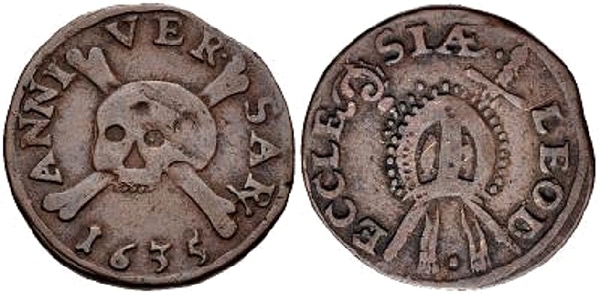
Since these méreaux were not intended for monetary use and struck from a low-value base metal, they varied greatly in weight. Various examples ranged in weight from 5.9 to 2.85 grams. Generally, however, the earlier the piece was struck, the lighter it is.
Saint Lambert also appeared on several other types of méreaux and non-religious tokens in the 17th and 18th centuries in Liege. One of the most common of these is undated but was struck around 1700. It depicts a mitered bust of Sant Lambert on the obverse and a veiled bust of the Virgin Mary on the reverse. The legends simply spell out the names of the two religious figures.
This church token has two main types. The first has Saint Lambert facing right and Mary facing left while on the second the busts are facing the opposite direction. The second type also has slightly different legends.

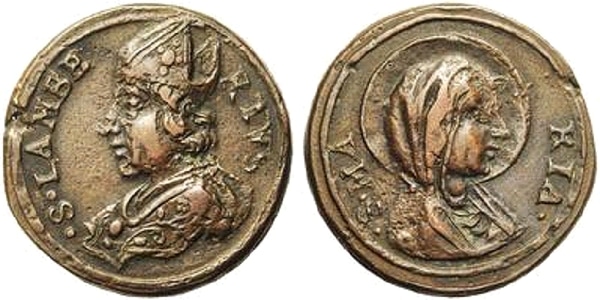
Another interesting type, while also undated, is believed to have been struck in the mid-17th century at a similar time as the Saint Lambert memento mori types. On the obverse in two lines is the word MANDATA, and on the reverse in three lines is S. LAMBERTUS. While simple, this communion token is clear in its purpose. The Latin word MANDATA translates into English as “Things Required”. While the word has various religious meanings, in this instance it refers to the fact that this méreaux was required for the barer to receive the Lord’s Supper.
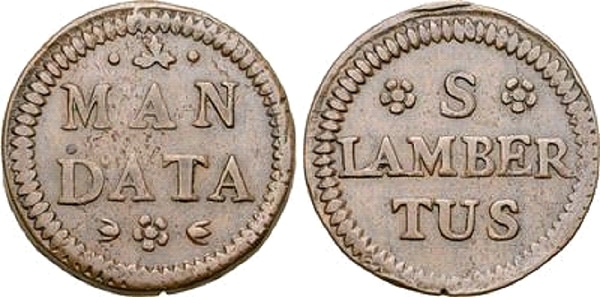
In addition to these church tokens, the city of Liege also struck a secular medal in silver and bronze to commemorate the 1,000th anniversary of Sant Lambert’s martyrdom. On the obverse sits Prince-Bishop Joseph-Clément of Bavaria, a controversial figure whose appointment was one of the sparks which caused the Nine Years War, flanked by 10 prelates. The reverse is an eight-lined legend describing the scene and the reason for striking the medal.
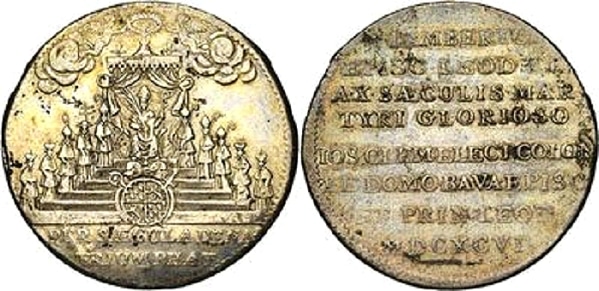
These tokens, and others like them from other cities in the Low Countries, offer a very interesting and varied topic for numismatists. Full of religious symbolism, these small communion tokens can provide endless hours of study.
Happy Collecting!
* * *
Sources
https://www.presbyteriansofthepast.com/2017/06/12/communion-tokens/
https://www.britishmuseum.org/collection/term/BIOG158178
https://www.lutheranforum.com/blog/adiaphora-mandata-damnabilia
* * *
About the Author
Tyler Rossi is currently a graduate student at Brandeis University’s Heller School of Social Policy and Management and studies Sustainable International Development and Conflict Resolution. Before graduating from American University in Washington D.C., he worked for Save the Children creating and running international development projects. Recently, Tyler returned to the US from living abroad in the Republic of North Macedonia, where he served as a Peace Corps volunteer for three years. Tyler is an avid numismatist and for over a decade has cultivated a deep interest in pre-modern and ancient coinage from around the world. He is a member of the American Numismatic Association (ANA).




